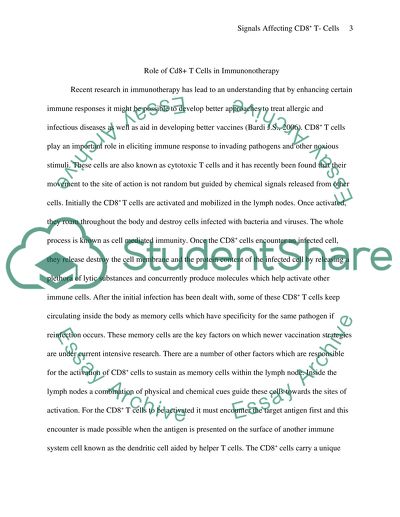Cite this document
(Signals Affecting Memory CD8 T-cell Response Essay Example | Topics and Well Written Essays - 1500 words, n.d.)
Signals Affecting Memory CD8 T-cell Response Essay Example | Topics and Well Written Essays - 1500 words. https://studentshare.org/medical-science/1545312-discuss-the-signals-that-shape-the-characteristics-of-the-memory-cd8-t-cell-response-and-discuss-how-manipulation-of-these-signals-has-the-potential-to-reshape-cd8-t-cell-memory-and-improve-the-efficacy-of-vaccination
Signals Affecting Memory CD8 T-cell Response Essay Example | Topics and Well Written Essays - 1500 words. https://studentshare.org/medical-science/1545312-discuss-the-signals-that-shape-the-characteristics-of-the-memory-cd8-t-cell-response-and-discuss-how-manipulation-of-these-signals-has-the-potential-to-reshape-cd8-t-cell-memory-and-improve-the-efficacy-of-vaccination
(Signals Affecting Memory CD8 T-Cell Response Essay Example | Topics and Well Written Essays - 1500 Words)
Signals Affecting Memory CD8 T-Cell Response Essay Example | Topics and Well Written Essays - 1500 Words. https://studentshare.org/medical-science/1545312-discuss-the-signals-that-shape-the-characteristics-of-the-memory-cd8-t-cell-response-and-discuss-how-manipulation-of-these-signals-has-the-potential-to-reshape-cd8-t-cell-memory-and-improve-the-efficacy-of-vaccination.
Signals Affecting Memory CD8 T-Cell Response Essay Example | Topics and Well Written Essays - 1500 Words. https://studentshare.org/medical-science/1545312-discuss-the-signals-that-shape-the-characteristics-of-the-memory-cd8-t-cell-response-and-discuss-how-manipulation-of-these-signals-has-the-potential-to-reshape-cd8-t-cell-memory-and-improve-the-efficacy-of-vaccination.
“Signals Affecting Memory CD8 T-Cell Response Essay Example | Topics and Well Written Essays - 1500 Words”. https://studentshare.org/medical-science/1545312-discuss-the-signals-that-shape-the-characteristics-of-the-memory-cd8-t-cell-response-and-discuss-how-manipulation-of-these-signals-has-the-potential-to-reshape-cd8-t-cell-memory-and-improve-the-efficacy-of-vaccination.


